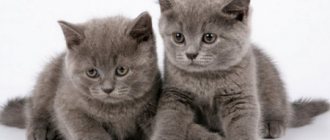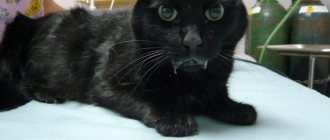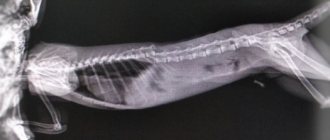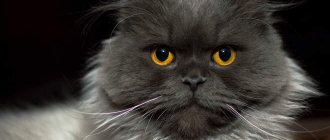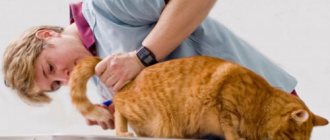The heart is one of the main organs in both humans and animals. The health and life expectancy of our pets depends on its work. The slightest disruptions in the cardiac system can lead to serious consequences. One of these problems can be a heart attack in a cat. The Murkoshi team recommends calling a veterinarian immediately if symptoms of this disease appear.
1) What is a heart attack? 2) Causes of the disease 3) Risk factors 4) Symptoms of an attack 5) First aid and treatment 6) Prevention
Do cats have heart attacks? The answer is yes!
Heart attack is not a veterinary term, but a complaint from pet owners!
A heart attack in cats is a manifestation of heart failure syndrome. This problem is associated with genetically determined heart disease in cats. Heart disease occurs in all breeds of cats, but most often in representatives of risk group breeds (British, Scottish, Sphynx, Persian, Maine Coon).
The article discusses the main causes, symptoms, treatment and first aid for a heart attack in cats. What are the main symptoms, causes, treatment and first aid for a heart attack in cats?
Diseases of the heart muscle in cats are hidden for a long time, but appear suddenly after stress, especially after castration and sterilization of apparently healthy animals. Therefore, it is recommended that cats be screened by a cardiologist before undergoing planned interventions.
Prevention
The main enemies of a cat’s heart are poor nutrition and a sedentary lifestyle. The right diet can slow down the progression of the disease, and in some cases even cure the underlying disease. To prevent heart failure in a cat, you need to monitor the proper nutrition of your tailed friend. Cats that lead a “sofa” lifestyle should be encouraged to be stirred up. The easiest and most effective way to do this is through games. The rich experience of Murkoshi volunteers suggests that it is enough to play 2-3 times a day for 15-20 minutes to provide your cat with a sufficient level of activity. At the shelter, volunteers and staff play with the cats every day, so they feel cheerful and confident even in a confined space.
Read more about the benefits of games: Why do cats play and how to do it correctly with them?
Additionally, some cats may have a genetic predisposition. Therefore, as soon as you get a pet, it is advisable to have a diagnostic test for heart disease. Consultation and observation by a specialist will reduce the risk of disease in cats. Monitor your kitten's health, follow a diet, including specialized food for cats with heart disease, see specialists, and in return receive the love and affection of your mustachioed friend, who will not be afraid of any heart attacks.
Causes of heart attack in cats
Cause of heart attack
- genetic changes in the structure and function of the myocardium, that is, various gene mutations. Most pathological genes for damage to heart cells in cats are in a “dormant” state, can be activated during the growth of animals, or can remain in a “dormant” state until the end of the animal’s life.
Cardiomyopathies are the immediate cause of heart attacks in cats.
The following cardiomyopathies are known in cats:
- Hypertrophic - hypertrophy of the walls of the left and sometimes right ventricle.
- Restrictive - fibrous degeneration of the myocardium, thickening of the heart muscle, with normal thickness of the walls of the heart.
- Right ventricular dysplasia of the right ventricle is a fibrofatty degeneration of the wall of the right ventricle.
- Dilated - a sharp decrease in the contractility of the left ventricular myocardium and expansion of its cavity with normal or reduced wall thickness.
- Stress-induced - reversible cardiopathy, which occurs after stress factors, is manifested by temporary thickening of the walls of the heart. This pathology is completely cured within 1-2 months if the symptoms of congestive heart failure are controlled.
- Secondary cardiomyopathies (for diseases of other internal organs)
- Unclassified cardiomyopathies (transitional forms, unstudied pathologies)
Caring for a sick animal
In the period after acute symptoms have resolved, your pet should be provided with special care that will help it live several more happy years.
New way of life
The main condition for recovery is complete rest. You can’t tug at your mustachioed friend again or allow him to jump from a height. It is worth limiting visits to public places. While walking, you should not go to parks with large concentrations of other animals that could chase or scare your recovering pet. It is better to refrain from walking altogether for a long time.
Stressful situations should be minimized. Do not allow rapid heartbeat.
The room where the patient lives must be well ventilated. However, it is unacceptable to allow the cat to be in drafts. Your pet should have a dark corner where he can hide from everyone.
What to feed your pet
Much attention in the post-infarction period is paid to nutrition. Now the menu should consist of easily digestible foods: carbohydrate foods, fermented milk products, fatty protein foods are excluded. Porridge can be cooked not only in water, but also in low-fat chicken broth.
Be sure to exclude lard, fish, smoked, fried and salted foods from the diet. You should not give your recovering friend food from your host’s table. It contains a large amount of seasonings and preservatives, which are bad for your health. But a diet of meat and vegetables is good for your pet.
If your pet is accustomed to eating ready-made industrial food, then you need to pay attention to its composition. They shouldn't be of poor quality. A recovering cat should be switched to premium food or higher, which can be purchased at veterinary pharmacies. In addition to nutrients, they contain elements and vitamins that are beneficial for the cardiovascular system. The names of the foods will be recommended by the treating veterinarian.
What are the symptoms of a heart attack in a cat?
- Increased breathing rate during sleep
- Increased breathing rate at rest
- Hard breath
- Decreased appetite
- Pale and cyanotic tongue
- Forced pose
- Excitation
- Decreased body temperature
- Weakness - exercise increases symptoms
Increased breathing rate during sleep and at rest.
Cats with a heart attack pant rapidly. Breathing is difficult, abdominal, sometimes with wheezing. The cat is trying to inhale with greater amplitude. The intercostal spaces and hypochondrium may sink during maximum inspiration. The most valuable symptom in sick cats is an increase in breathing rate during sleep more than 27 times per minute. This means that the animal may have pulmonary edema or fluid accumulation in the chest cavity and require emergency hospitalization.
A less accurate symptom of heart attack in a cat is an increase in resting respiratory rate of more than 30 times per minute.
Stress can affect the breathing rate of a healthy cat. However, if your cat has increased breathing at rest, you should also seek help from a veterinary clinic. Cats with a heart attack may scream and worry, move around and cannot find a place for themselves or a comfortable position.
Hearing loss in a cat due to a heart attack is not a typical symptom. Hearing loss is possible in severe heart failure, when there is insufficient oxygen supply to the brain. Cats very often die from a heart attack.
Diagnostics in a veterinary clinic
Due to the fact that signs of the disease go unnoticed or the owner reacts late to signs of pain, the pet does not always have time to get help in a timely manner. In severe cases, he dies immediately. You should not hesitate to contact a specialist at the slightest suspicion of a serious case. By seeing the symptoms and having a short conversation with the owner, the veterinarian can make an initial diagnosis.
The next step will be to differentiate a cat’s heart attack from other cardiovascular diseases that have similar symptoms: myocarditis, pericarditis, pancarditis, cardiomyopathy. The doctor will also check the patient for brain pathologies. Instrumental methods such as echocardiography, electrocardiography, and ultrasound help to study impaired functions. The latter analysis accurately determines the presence of malfunctions in the left or right ventricle.
For diagnostic purposes, a general blood test and biochemistry are performed. This allows us to detect leukocytosis (increased white blood cell count), increased erythrocyte sedimentation rate (ESR), changes in the level of phosphatase, amylase, creatinine, and heart enzymes.
First aid for a cat having a heart attack
- It is necessary to take your pet to a veterinary clinic as quickly as possible.
If an animal has a previously diagnosed heart disease and a sudden attack occurs, then you need to inject the cat intramuscularly with 0.5-1.0 ml of furosemide (Lasix) and urgently take the animal to the clinic. - During a heart attack, a cat should not be forcibly placed on its side.
It is advisable to raise the upper part of the animal’s body (so that the head is higher than the limbs).
At the clinic, doctors will use intravenous injections of furosemide. Provide oxygen to the animal's breathing. If necessary, the patient will be given sedatives. It is possible that drugs such as nitroglycerin, dobutamine, and vetmedin will be used.
First aid from the owner
The first thing to do if you suspect a heart attack is to call your veterinarian. According to the symptoms described by the owner, he will recommend giving the animal Corvalol or another drug.
IMPORTANT! You should not give any medications without a doctor’s instructions, otherwise your pet’s condition will only worsen!
What to do next:
- Provide the cat with complete rest - do not shift him or disturb him, do not make noise near him.
- The room in which the patient is located should be well ventilated; extreme heat and stuffiness should not be allowed.
- It is highly advisable to have a veterinarian come to your home. If this is not possible, ONLY use a carrier with a hard plastic bottom.
- Do not give water or food to the patient; if the veterinarian recommends any medications over the phone, give them strictly in liquid form or in the form of an injection.
Remember that you can’t help anything at home, so you definitely need to show the sick person to a specialist.
Good to know
- Can cats hide pain?
- Serval cats
- Urinary retention in cats
- Causes of pain syndrome in cats
- Feline Orofacial Pain Syndrome
- Catnip for cats
- How to care for an old cat?
- How to properly dry a cat?
- How to Choose a Kitten for your Home
- Pneumonia of Cats
- Causes of Sneezing in Cats
- Anatomy and physiology of the liver in cats
- The structure and functions of the thyroid gland in cats
- Measuring blood pressure in cats
- Current role of dexmedetomidine in clinical veterinary and medical anesthesia and intensive care
- Thyroid function testing in cats
- Gabapentin in cats and dogs
- Information content of hematological and echocardiographic preoperative screening indicators
- Historical background on hyperthyroidism in cats
- Hyperthyroidism in older cats
- Cardiac hypertrophy in cats
- Analysis of anamnestic data during preoperative examination of animals
- Study of anamnestic data in cats before general anesthesia
- Method for measuring blood pressure in cats
- ICD in cats (diagnosis and symptoms)
- Hyperthyroidism is suspected, but serum T4 concentration is normal
- Acute gastroenterocolitis in dogs (etiology, pathogenesis, diagnosis and treatment)
- Reducing mortality during anesthesia is an important task of veterinary anesthesiology
- Thrombosis in cats (general information, etiology, pathogenesis, clinical picture, diagnosis and treatment)
- Urolithiasis of small animals (etiology, pathogenesis, diagnosis and treatment)
- Congestive cardiomyopathy in cats (What is it? How to protect your pets)
- Gastrointestinal tract in dogs (anatomy and physiology)
How the heart works
The heart is a pump that pushes blood around the body. The arteries carry plasma containing the nutrients and oxygen needed by every cell in the body. The blood transfers them to tissues, takes away toxins, carbon dioxide and other breakdown products. It becomes dark in color and carries the poison through the veins to the organs that carry the poison out - to the lungs, liver, kidneys.
In mammals, the heart is complex. It consists of 2 atria, 2 ventricles, valves separating them, and the rhythm is set by electricity. It works according to this scheme:
- Blood with carbon dioxide enters the right atrium, from there into the right ventricle and lungs.
- Here it is purified, gives off carbon dioxide, receives oxygen and passes into the left atrium, then into the ventricle.
- Before releasing blood into the body, the left ventricle contracts. Then the valve opens and the heart forcefully pumps blood into the aorta, the largest vessel in the body.
- Further, the plasma is distributed through smaller arteries and, through capillaries, transfers beneficial substances to tissues and removes toxins.
What can cause heart disease in animals
Depending on the origin, myocardial pathologies are divided into 2 large groups:
- Congenital – defects of blood vessels and valves. Problems with the myocardium occur in young pets, often up to a year old - shortness of breath, cyanotic tongue, fainting. Symptoms vary depending on the severity of the disease, ranging from subtle symptoms to death.
- Acquired - heart problems often appear with age, mainly after 7, less often 2-3 years. They can also be the result of injuries, neoplasms, past diseases - viral, bacterial, parasitic, autoimmune.
Major heart diseases
Depending on the area of damage, the following diseases are distinguished:
- Pathologies of the heart muscle (myocardium).
- Problems with the heart valve (defect).
- Arrhythmia is an abnormal heart rhythm.
- Endocarditis is inflammation of the endocardium, the inner lining of the heart muscle. The cause of the disease is a bacterial infection that damages myocardial tissue, causing erosions. Complications – valve deformation, heart failure, abscess of internal organs.
- Pericarditis is an inflammation of the serous membrane of the myocardium, when the volume of fluid increases in it, complicating the work of the myocardium. The pathology occurs in cats, middle-aged and elderly dogs. Causes include infection, acute allergies, penetrating chest injuries, sepsis, and tumors.
Constriction of blood vessels leads to increased blood pressure. This increases the load on the heart, which, when pumping, is forced to exert greater force so that the blood can reach all parts of the body. The result is premature wear of the myocardium.
A separate group can be divided into a heart attack, the causes of which are stenosis (persistent narrowing of veins and arteries) or blockage of a coronary vessel by a thrombus. If it is partially blocked, blood can flow, the animal will survive, although it will suffer. If the blockage is complete, the pet will most likely die.
Symptoms
It is possible to describe the symptoms of pulmonary edema only in general terms, since certain types of pathology occur with blurred characteristics. Signs include the following:
- severe weakness;
- shallow, very rapid breathing;
- dry cough;
- dry wheezing;
- severe shortness of breath;
- puffiness of the face and neck;
- bubbling breathing and moist wheezing;
- foam at the mouth with a pink tint;
- lethargy, confusion;
- shallow breathing;
- thready pulse.
Some signs of pulmonary edema contradict each other for the reason that everything can start with one condition and end with another. For example, rapid breathing occurs for several minutes or hours, and then it weakens. In the fastest and most dangerous forms of edema, the patient's death occurs from suffocation (asphyxia).
Are you experiencing symptoms of pulmonary edema?
Only a doctor can accurately diagnose the disease. Don't delay your consultation - call
What is sudden death?
The name speaks for itself: this is the sudden death of an animal (be it a dog, a cat...). In the case of cats, his own survival instinct has developed so much that he knows well how to hide pain; in fact, he will only show signs of weakness if he is very confident in his person and if he also lives in a quiet and pleasant environment.
Therefore, it is very important to pay attention to the cats that we have at home, since any symptoms, any small changes in your daily routine could be a sign of illness.
© shutterstock
How to avoid this?
Well, you need to know that the only way to avoid sudden death in cats is to make sure they are okay. They need to be fed a high quality diet (no grains or by-products) and it is also very important that they receive anti-parasitic treatment so that they are protected from parasites, both external and internal.
Additionally, we must take them to the vet whenever we suspect something is wrong with them, as well as vaccinate and neuter them before they become eager.


